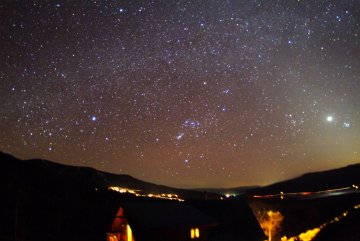 Did you miss last night's auroras? Next time get a wake-up call from Spaceweather PHONE.
Did you miss last night's auroras? Next time get a wake-up call from Spaceweather PHONE.
CRESCENT MOON: When the sun sets tonight, step outside and look west. An exquisitely beautiful crescent moon is emerging from the sun's glare. More than that, it's gliding by 4th-magnitude Comet Encke. Both moon and comet may be seen with binoculars or a wide field telescope. [sky map] [ephemeris]
ASTEROID 2007 HA: Watch this movie. It shows asteroid 2007 HA flying past Earth yesterday 2.5 million kilometers away. Amateur astronomer Greg Selleck filmed the flyby from his home in Madison, Wisconsin. At 13th magnitude, the space rock was an easy target for large backyard telescopes.
In Hungary, Vince Tuboly and Tibor Horváth caught the asteroid gliding past irregular galaxy NGC 4449:

The asteroid-galaxy conjunction was also photographed by Ivan Majchrovic and the BPU Team of Marianka, Slovakia: click here.
Remarkably, this bright near-Earth asteroid was utterly unknown only two days ago; it was discovered by MIT's LINEAR program on April 16th. While most asteroids hail from the asteroid belt between Mars and Jupiter, 2007 HA comes from the direction of the Sun. Its orbit is contained almost entirely inside the orbit of Earth, making 2007 HA a member of the rare but growing family of Aten asteroids.
X IN THE SKY: If you live far from city lights, you may be able to see a faint but beautiful spectacle in the western sky tonight after sunset--a giant, glowing X. Physics professor Jimmy Westlake took this picture near Stagecoach, Colorado, on April 14th:

Photo details: Fuji Finepix S2, 16mm Nikkor fisheye lens, ISO 800, 2 minutes
"It was spectacular," he says. "The bright, yellowish zodiacal light crossed the blue band of the Milky Way forming a large X in the sky. Venus and the Pleiades were completely immersed in zodiacal glow."
Zodiacal light--sunlight reflected from dust littering the plane of the solar system--is very faint. Even the slender crescent moon can interfere with it; so wait until the moon sets and allow your eyes time to fully adjust to the darkness. Or let your camera do the work: "I took this picture using a Fuji FinePix S2 digital camera set at ISO 800," explains Westlake. "It was a 2-minute guided exposure with a 16-mm Nikkor fisheye lens at f2.8."

